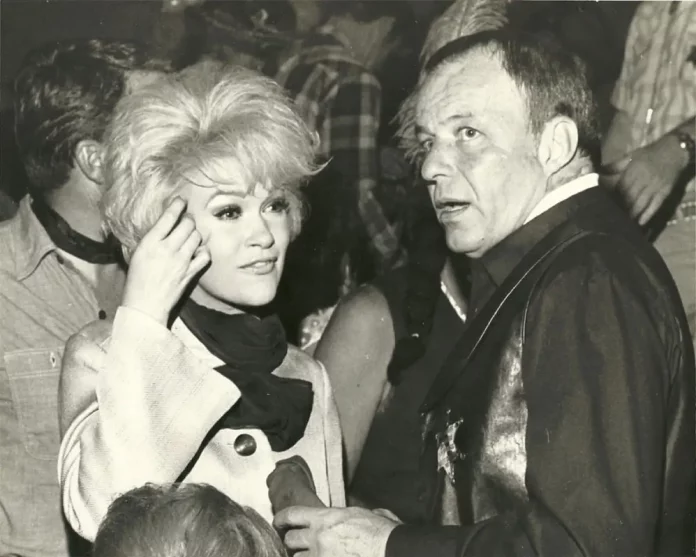Opportunities for Raney to perform and record became less frequent as the 70s wore on and demand for her style of singing continued to decline. She responded by going into jingles production, writing and recording advertisements. She also began teaching voice around this time, eventually earning a reputation as one of the top vocal coaches in the L.A. area.
She performed when she could, enjoying a reputation as a kind of cult figure. Her fans were not limited to the cognoscenti, however: “Frank Sinatra happened to come to the Chi Chi Club in Palm Springs, and I was opening for Pat Henry. I was doing a medley of Michel Legrand and Alan and Marilyn Bergman from The Umbrellas Of Cherbourg . . . I finished the medley and the spotlight was [shining] in my eyes. This person stands up and gives me a standing ovation, and it was Frank Sinatra . . . There it was, the outline of him in the spotlight that was in my eyes. It was a magic moment for me.”
More such magic moments were to occur as things began to pick up performance-wise in the following decade. Signing with Discovery Records turned out to be a particularly fortuitous move, leading to several excellent tribute albums in the 80s. Among them were one each dedicated to the music of Johnny Mandel, Henry Mancini and the Bergmans, Alan and Marilyn.
These albums present Raney in her undisputed prime, singing with greater assurance and range than ever. Fearless, she’s able to nail a high F and make it sound natural, not gimmicky. She shades with controlled vibrato at the ends of phrases. She is devastating on ballads, channelling pure, uncut emotion. She unleashes her power when appropriate but never strains, interpreting lyrics with intelligence and fealty to the intent of the songwriters whose work she uplifts no matter what she sings.
‘At 17 years old to be at the Capitol recording studio, having Nelson Riddle do my first album . . . I was a lucky little girl, and a lot of times, I was a scared little girl’
Helping tell her stories during this period were some of the best jazz musicians on the West Coast. On the 1988 Discovery album In Good Company, she more than holds her own with jazz heavyweights Conte Candoli, Bob Cooper, Bill Watrous, Alan Broadbent, Jake Hanna, and others. During this period, she also worked with the vocal group L.A. Voices, a format she had previously enjoyed in the early 60s with The Four Freshmen.
In the 90s, a fruitful association with Jordi Pujol’s Fresh Sound label yielded a critically acclaimed Doris Day tribute album called Heart’s Desire (1997). The title track – a Dave Frishberg composition – is the only selection not associated with Day, an early influence for Raney. The tune reveals the reverence Raney felt for the subject of this fine tribute as she follows her heart’s desire in presenting definitive versions of these tunes clothed in full orchestral colour by frequent collaborator Alan Broadbent.
Fresh Sound also released a two-CD set of her complete Capitol output, including the three albums and all her singles for the label. Her most recent recordings for Fresh Sound are Christmas Lady (2016) and Late In Life (2015), a romantic tribute to the love of her life, Mr. Fanzone, whom she wed in 1985. “My husband and I met late in life. I chose songs that would be something I’d say to my husband . . . I came up with every song on Late In Life . . . they were all my choices.”
Retired now, Raney looks back on her career with satisfaction and gratitude for the chances she was given at such an early age. “I started really early, and – I can’t even tell you – at 17 years old to be at the Capitol recording studio, having Nelson Riddle do my first album . . . I was a lucky little girl, and a lot of times, I was a scared little girl.”
Scared? You’d not think so from listening to her sing and watching her perform. Take her appearance on the Dean Martin show. As soon as Dino introduces her, she rules the stage with her sunny California-girl disposition, her composure, her distinctive head of blonde curls and her long gold gown: you can’t take your eyes off her. Remembering what she said about meeting Martin for the first time on stage, in front of a live audience, one marvels at how relaxed and in sync they are in their duet bit following her feature. They spar and joust. They schmooze. They sizzle. They tap a succession of show tunes and standards (You’ve Got Possibilities, I Got Plenty O’ Nuttin’, Teach Me Tonight, The Glory Of Love) to present a coy romantic vignette that starts off with her criticising his dress and bearing and ends up with him taking her in his arms as though they had fallen in love. The routine is a reminder of the sort of delightful fare no longer seen on television, as well as a tribute to the amazing Raney who all but upstages Martin every step of the way.
So perhaps the City of the Angels is not so pitiable after all. Having a singer who uplifts this oft-maligned place with a voice to match its name is surely consolation for its less-than-savoury reputation, deserved or not. And while LA may proudly claim her and her heavenly voice, the singular talents of Sue Raney will appeal to anyone who enjoys good songs, well sung.
Or in Ms. Raney’s case, angelically sung.
















